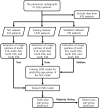Age-group determination of living individuals using first molar images based on artificial intelligence
- PMID: 33441753
- PMCID: PMC7806774
- DOI: 10.1038/s41598-020-80182-8
Age-group determination of living individuals using first molar images based on artificial intelligence
Erratum in
-
Author Correction: Age-group determination of living individuals using first molar images based on artificial intelligence.Sci Rep. 2022 Feb 7;12(1):2332. doi: 10.1038/s41598-022-06543-7. Sci Rep. 2022. PMID: 35132161 Free PMC article. No abstract available.
Abstract
Dental age estimation of living individuals is difficult and challenging, and there is no consensus method in adults with permanent dentition. Thus, we aimed to provide an accurate and robust artificial intelligence (AI)-based diagnostic system for age-group estimation by incorporating a convolutional neural network (CNN) using dental X-ray image patches of the first molars extracted via panoramic radiography. The data set consisted of four first molar images from the right and left sides of the maxilla and mandible of each of 1586 individuals across all age groups, which were extracted from their panoramic radiographs. The accuracy of the tooth-wise estimation was 89.05 to 90.27%. Performance accuracy was evaluated mainly using a majority voting system and area under curve (AUC) scores. The AUC scores ranged from 0.94 to 0.98 for all age groups, which indicates outstanding capacity. The learned features of CNNs were visualized as a heatmap, and revealed that CNNs focus on differentiated anatomical parameters, including tooth pulp, alveolar bone level, or interdental space, depending on the age and location of the tooth. With this, we provided a deeper understanding of the most informative regions distinguished by age groups. The prediction accuracy and heat map analyses support that this AI-based age-group determination model is plausible and useful.
Conflict of interest statement
The authors declare no competing interests.
Figures






Similar articles
-
Tooth coronal index and pulp/tooth ratio in dental age estimation on digital panoramic radiographs-A comparative study.Forensic Sci Int. 2017 Aug;277:115-121. doi: 10.1016/j.forsciint.2017.05.006. Epub 2017 May 12. Forensic Sci Int. 2017. PMID: 28645095
-
Artificial intelligence and dental age estimation: development and validation of an automated stage allocation technique on all mandibular tooth types in panoramic radiographs.Int J Legal Med. 2024 Nov;138(6):2469-2479. doi: 10.1007/s00414-024-03298-w. Epub 2024 Aug 6. Int J Legal Med. 2024. PMID: 39105781
-
Age estimation standards for a Western Australian population using the coronal pulp cavity index.Forensic Sci Int. 2013 Sep 10;231(1-3):412.e1-6. doi: 10.1016/j.forsciint.2013.04.004. Epub 2013 May 7. Forensic Sci Int. 2013. PMID: 23664550
-
Usability of dental pulp visibility and tooth coronal index in digital panoramic radiography in age estimation in the forensic medicine.Int J Legal Med. 2020 Jan;134(1):381-392. doi: 10.1007/s00414-019-02188-w. Epub 2019 Nov 13. Int J Legal Med. 2020. PMID: 31720771
-
Efficacy of the methods of age determination using artificial intelligence in panoramic radiographs - a systematic review.Int J Legal Med. 2024 Jul;138(4):1459-1496. doi: 10.1007/s00414-024-03162-x. Epub 2024 Feb 24. Int J Legal Med. 2024. PMID: 38400923
Cited by
-
Automated Age Estimation from OPG Images and Patient Records Using Deep Feature Extraction and Modified Genetic-Random Forest.Diagnostics (Basel). 2025 Jan 29;15(3):314. doi: 10.3390/diagnostics15030314. Diagnostics (Basel). 2025. PMID: 39941244 Free PMC article.
-
Dental age estimation using a convolutional neural network algorithm on panoramic radiographs: A pilot study in Indonesia.Imaging Sci Dent. 2025 Mar;55(1):28-36. doi: 10.5624/isd.20240134. Epub 2025 Mar 10. Imaging Sci Dent. 2025. PMID: 40191398 Free PMC article.
-
Validation of data mining models by comparing with conventional methods for dental age estimation in Korean juveniles and young adults.Sci Rep. 2023 Jan 13;13(1):726. doi: 10.1038/s41598-023-28086-1. Sci Rep. 2023. PMID: 36639726 Free PMC article.
-
Estimation of human age using machine learning on panoramic radiographs for Brazilian patients.Sci Rep. 2024 Aug 24;14(1):19689. doi: 10.1038/s41598-024-70621-1. Sci Rep. 2024. PMID: 39181957 Free PMC article.
-
Application of entire dental panorama image data in artificial intelligence model for age estimation.BMC Oral Health. 2023 Dec 15;23(1):1007. doi: 10.1186/s12903-023-03745-x. BMC Oral Health. 2023. PMID: 38102578 Free PMC article.
References
Publication types
MeSH terms
LinkOut - more resources
Full Text Sources
Other Literature Sources
Medical

